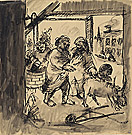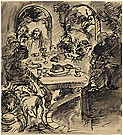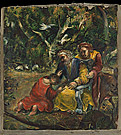Exhibition themes Harkaway mural
The Harkaway Mural
In 1948 Arthur Boyd was commissioned by his uncle, the novelist Martin Boyd, to paint his largest commission—a major mural in the dining room of The Grange, at Harkaway near Berwick, built by their forebears in 1866. Martin had returned to Australia from England to reclaim and restore this family home.
Arthur was enthusiastic about the commission, undertaking numerous preparatory drawings and finalizing the subject matter in consultation with his uncle. He played Beethoven’s 7th Symphony very loudly as he painted the mural in a ‘fresco secco’ method over a plaster ground. On the only wall of the dining room with no apertures, the focal point was The prodigal son. Franz Philipp, author of the first monograph on Arthur Boyd (published in 1967) wrote of this component:
‘The artist depicts the “Return of the Prodigal”, with its message of contrition and loving forgiveness … The landscape painted with wonderful warmth and freedom, is one of Boyd’s masterpieces. The focal colouristic accent of the figure group—the golden yellow of the father’s garment—rises with a warm Venetian richness out of the cooler hues of the lush, sunlit river bank.’
Sadly in the late 1960s, after Martin Boyd had left Australia, The Grange was demolished to make way for a quarry. In an effort to save the mural, four large fragments were encased in concrete so heavy that it became a great risk to move or exhibit them safely. The current display of this restored component of the mural, for the first time since 1969, is momentous. It has only been made possible with considerable efforts by a team at the Gallery, as well as by external specialists and engineers. It represents the reclamation of a lost treasure and part of Boyd’s family heritage.



![Arthur BOYD | Figures in landscape with bridge [recto]; not titled [trees] [verso] | 1944-1949](images/sml/82679.jpg)


